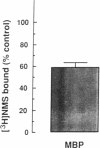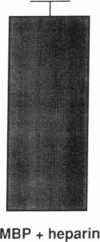Abstract
The effect of human eosinophil major basic protein (MBP) as well as other eosinophil proteins, on binding of [3H]N-methyl-scopolamine ([3H]NMS: 1 x 10(-10) M) to muscarinic M2 receptors in heart membranes and M3 receptors in submandibular gland membranes was studied. MBP inhibited specific binding of [3H]NMS to M2 receptors but not to M3 receptors. MBP also inhibited atropine-induced dissociation of [3H]NMS-receptor complexes in a dose-dependent fashion, demonstrating that the interaction of MBP with the M2 muscarinic receptor is allosteric. This effect of MBP suggests that it may function as an endogenous allosteric inhibitor of agonist binding to the M2 muscarinic receptor. Inhibition of [3H]NMS binding by MBP was reversible by treatment with heparin, which binds and neutralizes MBP. Eosinophil peroxidase (EPO) also inhibited specific binding of [3H]NMS to M2 receptors but not to M3 receptors and inhibited atropine-induced dissociation of [3H]NMS-receptor complexes. On a molar basis, EPO is less potent than MBP. Neither eosinophil cationic protein nor eosinophil-derived neurotoxin affected binding of [3H]NMS to M2 receptors. Thus both MBP and EPO are selective allosteric antagonists at M2 receptors. The effects of these proteins may be important causes of M2 receptor dysfunction and enhanced vagally mediated bronchoconstriction in asthma.
Full text
PDF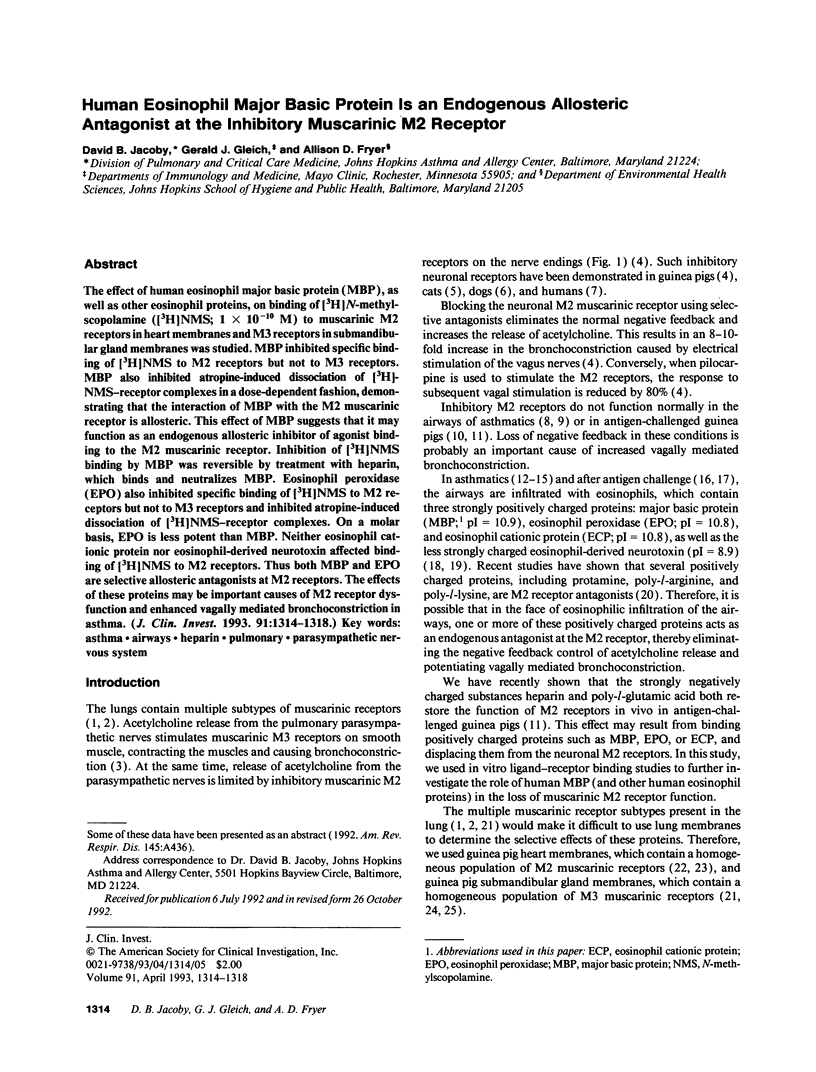
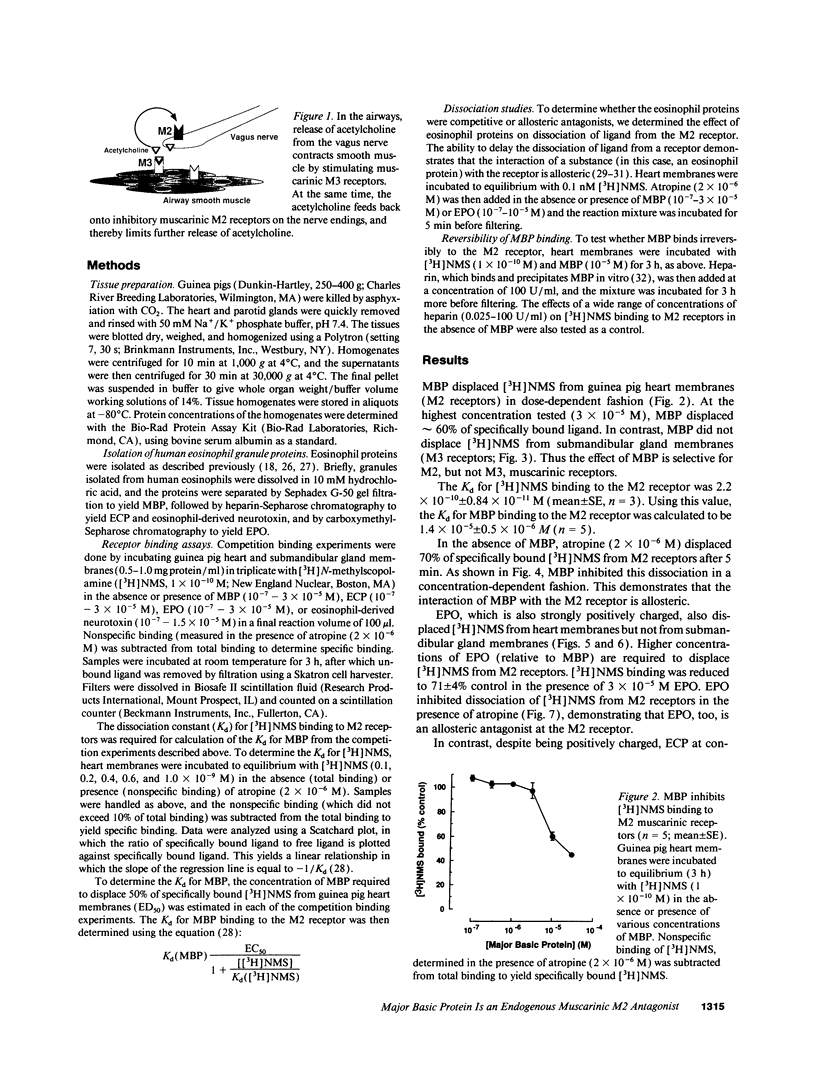
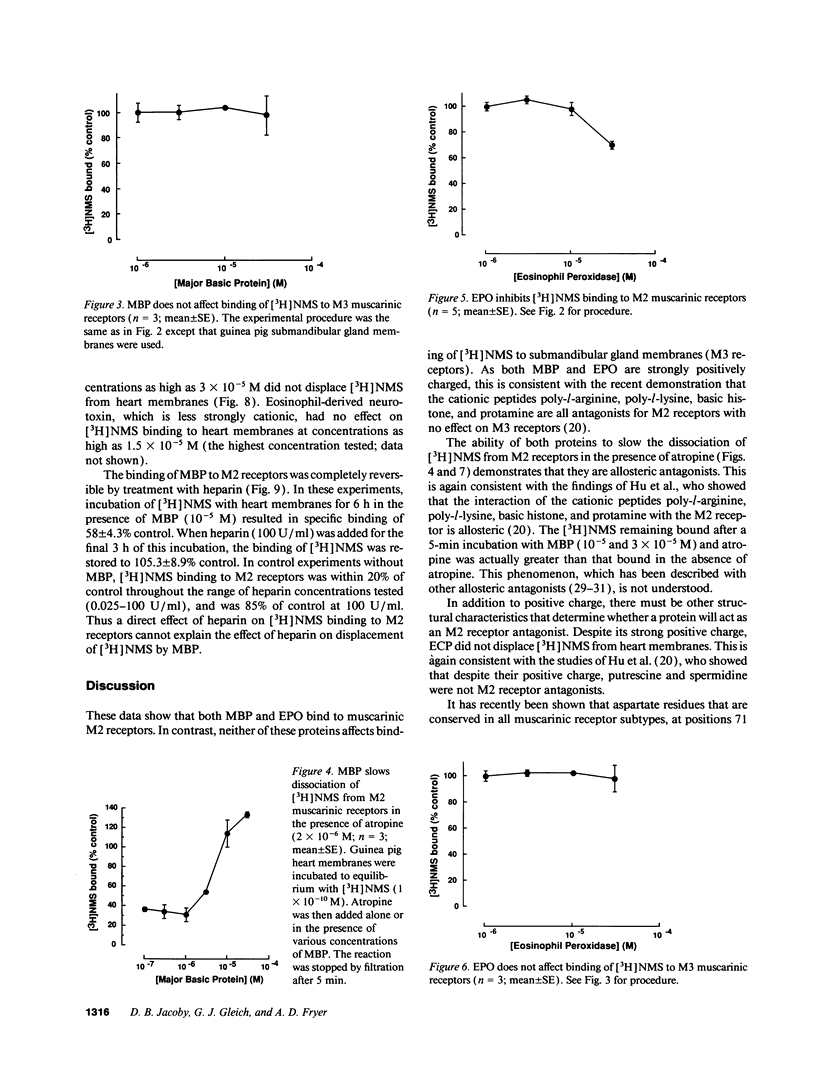
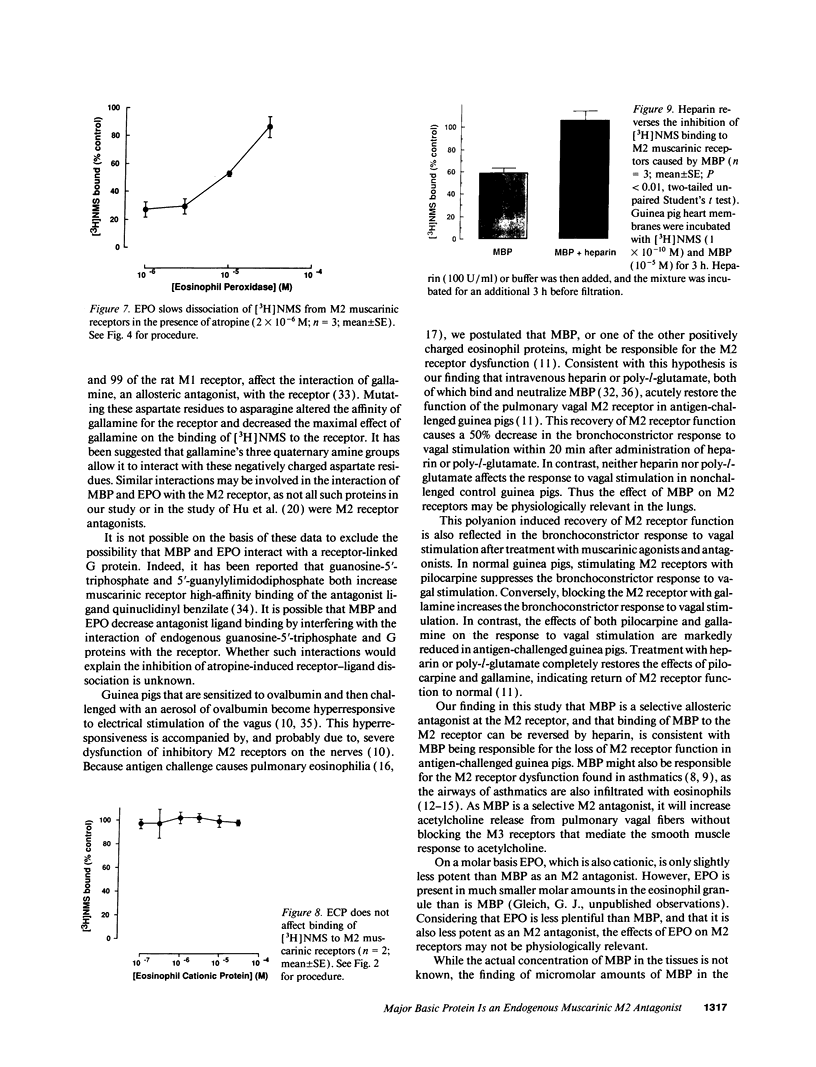
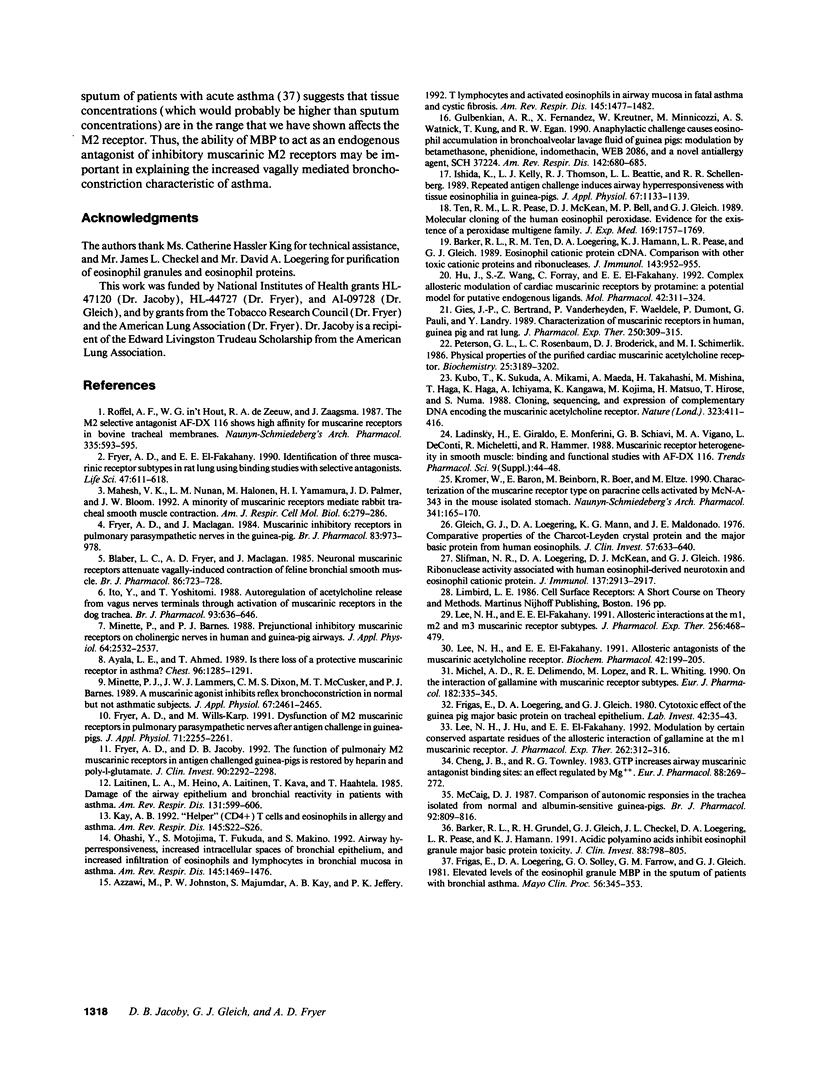
Images in this article
Selected References
These references are in PubMed. This may not be the complete list of references from this article.
- Ayala L. E., Ahmed T. Is there loss of protective muscarinic receptor mechanism in asthma? Chest. 1989 Dec;96(6):1285–1291. doi: 10.1378/chest.96.6.1285. [DOI] [PubMed] [Google Scholar]
- Azzawi M., Johnston P. W., Majumdar S., Kay A. B., Jeffery P. K. T lymphocytes and activated eosinophils in airway mucosa in fatal asthma and cystic fibrosis. Am Rev Respir Dis. 1992 Jun;145(6):1477–1482. doi: 10.1164/ajrccm/145.6.1477. [DOI] [PubMed] [Google Scholar]
- Barker R. L., Gundel R. H., Gleich G. J., Checkel J. L., Loegering D. A., Pease L. R., Hamann K. J. Acidic polyamino acids inhibit human eosinophil granule major basic protein toxicity. Evidence of a functional role for ProMBP. J Clin Invest. 1991 Sep;88(3):798–805. doi: 10.1172/JCI115379. [DOI] [PMC free article] [PubMed] [Google Scholar]
- Barker R. L., Loegering D. A., Ten R. M., Hamann K. J., Pease L. R., Gleich G. J. Eosinophil cationic protein cDNA. Comparison with other toxic cationic proteins and ribonucleases. J Immunol. 1989 Aug 1;143(3):952–955. [PubMed] [Google Scholar]
- Blaber L. C., Fryer A. D., Maclagan J. Neuronal muscarinic receptors attenuate vagally-induced contraction of feline bronchial smooth muscle. Br J Pharmacol. 1985 Nov;86(3):723–728. doi: 10.1111/j.1476-5381.1985.tb08951.x. [DOI] [PMC free article] [PubMed] [Google Scholar]
- Cheng J. B., Townley R. G. GTP increases airway muscarinic antagonist binding sites: an effect regulated by Mg2+. Eur J Pharmacol. 1983 Mar 25;88(2-3):269–272. doi: 10.1016/0014-2999(83)90017-1. [DOI] [PubMed] [Google Scholar]
- Frigas E., Loegering D. A., Gleich G. J. Cytotoxic effects of the guinea pig eosinophil major basic protein on tracheal epithelium. Lab Invest. 1980 Jan;42(1):35–43. [PubMed] [Google Scholar]
- Frigas E., Loegering D. A., Solley G. O., Farrow G. M., Gleich G. J. Elevated levels of the eosinophil granule major basic protein in the sputum of patients with bronchial asthma. Mayo Clin Proc. 1981 Jun;56(6):345–353. [PubMed] [Google Scholar]
- Fryer A. D., Jacoby D. B. Function of pulmonary M2 muscarinic receptors in antigen-challenged guinea pigs is restored by heparin and poly-L-glutamate. J Clin Invest. 1992 Dec;90(6):2292–2298. doi: 10.1172/JCI116116. [DOI] [PMC free article] [PubMed] [Google Scholar]
- Fryer A. D., Maclagan J. Muscarinic inhibitory receptors in pulmonary parasympathetic nerves in the guinea-pig. Br J Pharmacol. 1984 Dec;83(4):973–978. doi: 10.1111/j.1476-5381.1984.tb16539.x. [DOI] [PMC free article] [PubMed] [Google Scholar]
- Fryer A. D., Wills-Karp M. Dysfunction of M2-muscarinic receptors in pulmonary parasympathetic nerves after antigen challenge. J Appl Physiol (1985) 1991 Dec;71(6):2255–2261. doi: 10.1152/jappl.1991.71.6.2255. [DOI] [PubMed] [Google Scholar]
- Fryer A. D., el-Fakahany E. E. Identification of three muscarinic receptor subtypes in rat lung using binding studies with selective antagonists. Life Sci. 1990;47(7):611–618. doi: 10.1016/0024-3205(90)90572-9. [DOI] [PubMed] [Google Scholar]
- Gies J. P., Bertrand C., Vanderheyden P., Waeldele F., Dumont P., Pauli G., Landry Y. Characterization of muscarinic receptors in human, guinea pig and rat lung. J Pharmacol Exp Ther. 1989 Jul;250(1):309–315. [PubMed] [Google Scholar]
- Gleich G. J., Loegering D. A., Mann K. G., Maldonado J. E. Comparative properties of the Charcot-Leyden crystal protein and the major basic protein from human eosinophils. J Clin Invest. 1976 Mar;57(3):633–640. doi: 10.1172/JCI108319. [DOI] [PMC free article] [PubMed] [Google Scholar]
- Gulbenkian A. R., Fernandez X., Kreutner W., Minnicozzi M., Watnick A. S., Kung T., Egan R. W. Anaphylactic challenge causes eosinophil accumulation in bronchoalveolar lavage fluid of guinea pigs. Modulation by betamethasone, phenidone, indomethacin, WEB 2086, and a novel antiallergy agent, SCH 37224. Am Rev Respir Dis. 1990 Sep;142(3):680–685. doi: 10.1164/ajrccm/142.3.680. [DOI] [PubMed] [Google Scholar]
- Hu J., Wang S. Z., Forray C., el-Fakahany E. E. Complex allosteric modulation of cardiac muscarinic receptors by protamine: potential model for putative endogenous ligands. Mol Pharmacol. 1992 Aug;42(2):311–321. [PubMed] [Google Scholar]
- Ishida K., Kelly L. J., Thomson R. J., Beattie L. L., Schellenberg R. R. Repeated antigen challenge induces airway hyperresponsiveness with tissue eosinophilia in guinea pigs. J Appl Physiol (1985) 1989 Sep;67(3):1133–1139. doi: 10.1152/jappl.1989.67.3.1133. [DOI] [PubMed] [Google Scholar]
- Ito Y., Yoshitomi T. Autoregulation of acetylcholine release from vagus nerve terminals through activation of muscarinic receptors in the dog trachea. Br J Pharmacol. 1988 Mar;93(3):636–646. doi: 10.1111/j.1476-5381.1988.tb10321.x. [DOI] [PMC free article] [PubMed] [Google Scholar]
- Kay A. B. "Helper" (CD4+) T cells and eosinophils in allergy and asthma. Am Rev Respir Dis. 1992 Feb;145(2 Pt 2):S22–S26. doi: 10.1164/ajrccm/145.2_Pt_2.S22. [DOI] [PubMed] [Google Scholar]
- Kromer W., Baron E., Beinborn M., Boer R., Eltze M. Characterization of the muscarine receptor type on paracrine cells activated by McN-A-343 in the mouse isolated stomach. Naunyn Schmiedebergs Arch Pharmacol. 1990 Mar;341(3):165–170. doi: 10.1007/BF00169726. [DOI] [PubMed] [Google Scholar]
- Kubo T., Fukuda K., Mikami A., Maeda A., Takahashi H., Mishina M., Haga T., Haga K., Ichiyama A., Kangawa K. Cloning, sequencing and expression of complementary DNA encoding the muscarinic acetylcholine receptor. Nature. 1986 Oct 2;323(6087):411–416. doi: 10.1038/323411a0. [DOI] [PubMed] [Google Scholar]
- Ladinsky H., Giraldo E., Monferini E., Schiavi G. B., Viganò M. A., De Conti L., Micheletti R., Hammer R. Muscarinic receptor heterogeneity in smooth muscle: binding and functional studies with AF-DX 116. Trends Pharmacol Sci. 1988 Feb;Suppl:44–48. [PubMed] [Google Scholar]
- Laitinen L. A., Heino M., Laitinen A., Kava T., Haahtela T. Damage of the airway epithelium and bronchial reactivity in patients with asthma. Am Rev Respir Dis. 1985 Apr;131(4):599–606. doi: 10.1164/arrd.1985.131.4.599. [DOI] [PubMed] [Google Scholar]
- Lee N. H., Hu J., el-Fakahany E. E. Modulation by certain conserved aspartate residues of the allosteric interaction of gallamine at the m1 muscarinic receptor. J Pharmacol Exp Ther. 1992 Jul;262(1):312–316. [PubMed] [Google Scholar]
- Lee N. H., el-Fakahany E. E. Allosteric antagonists of the muscarinic acetylcholine receptor. Biochem Pharmacol. 1991 Jul 5;42(2):199–205. doi: 10.1016/0006-2952(91)90703-8. [DOI] [PubMed] [Google Scholar]
- Lee N. H., el-Fakahany E. E. Allosteric interactions at the m1, m2 and m3 muscarinic receptor subtypes. J Pharmacol Exp Ther. 1991 Feb;256(2):468–479. [PubMed] [Google Scholar]
- Mahesh V. K., Nunan L. M., Halonen M., Yamamura H. I., Palmer J. D., Bloom J. W. A minority of muscarinic receptors mediate rabbit tracheal smooth muscle contraction. Am J Respir Cell Mol Biol. 1992 Mar;6(3):279–286. doi: 10.1165/ajrcmb/6.3.279. [DOI] [PubMed] [Google Scholar]
- McCaig D. J. Comparison of autonomic responses in the trachea isolated from normal and albumin-sensitive guinea-pigs. Br J Pharmacol. 1987 Dec;92(4):809–816. doi: 10.1111/j.1476-5381.1987.tb11385.x. [DOI] [PMC free article] [PubMed] [Google Scholar]
- Michel A. D., Delmendo R. E., Lopez M., Whiting R. L. On the interaction of gallamine with muscarinic receptor subtypes. Eur J Pharmacol. 1990 Jul 3;182(2):335–345. doi: 10.1016/0014-2999(90)90292-e. [DOI] [PubMed] [Google Scholar]
- Minette P. A., Barnes P. J. Prejunctional inhibitory muscarinic receptors on cholinergic nerves in human and guinea pig airways. J Appl Physiol (1985) 1988 Jun;64(6):2532–2537. doi: 10.1152/jappl.1988.64.6.2532. [DOI] [PubMed] [Google Scholar]
- Minette P. A., Lammers J. W., Dixon C. M., McCusker M. T., Barnes P. J. A muscarinic agonist inhibits reflex bronchoconstriction in normal but not in asthmatic subjects. J Appl Physiol (1985) 1989 Dec;67(6):2461–2465. doi: 10.1152/jappl.1989.67.6.2461. [DOI] [PubMed] [Google Scholar]
- Ohashi Y., Motojima S., Fukuda T., Makino S. Airway hyperresponsiveness, increased intracellular spaces of bronchial epithelium, and increased infiltration of eosinophils and lymphocytes in bronchial mucosa in asthma. Am Rev Respir Dis. 1992 Jun;145(6):1469–1476. doi: 10.1164/ajrccm/145.6.1469. [DOI] [PubMed] [Google Scholar]
- Peterson G. L., Rosenbaum L. C., Broderick D. J., Schimerlik M. I. Physical properties of the purified cardiac muscarinic acetylcholine receptor. Biochemistry. 1986 Jun 3;25(11):3189–3202. doi: 10.1021/bi00359a017. [DOI] [PubMed] [Google Scholar]
- Roffel A. F., in't Hout W. G., de Zeeuw R. A., Zaagsma J. The M2 selective antagonist AF-DX 116 shows high affinity for muscarine receptors in bovine tracheal membranes. Naunyn Schmiedebergs Arch Pharmacol. 1987 May;335(5):593–595. doi: 10.1007/BF00169130. [DOI] [PubMed] [Google Scholar]
- Slifman N. R., Loegering D. A., McKean D. J., Gleich G. J. Ribonuclease activity associated with human eosinophil-derived neurotoxin and eosinophil cationic protein. J Immunol. 1986 Nov 1;137(9):2913–2917. [PubMed] [Google Scholar]
- Ten R. M., Pease L. R., McKean D. J., Bell M. P., Gleich G. J. Molecular cloning of the human eosinophil peroxidase. Evidence for the existence of a peroxidase multigene family. J Exp Med. 1989 May 1;169(5):1757–1769. doi: 10.1084/jem.169.5.1757. [DOI] [PMC free article] [PubMed] [Google Scholar]




